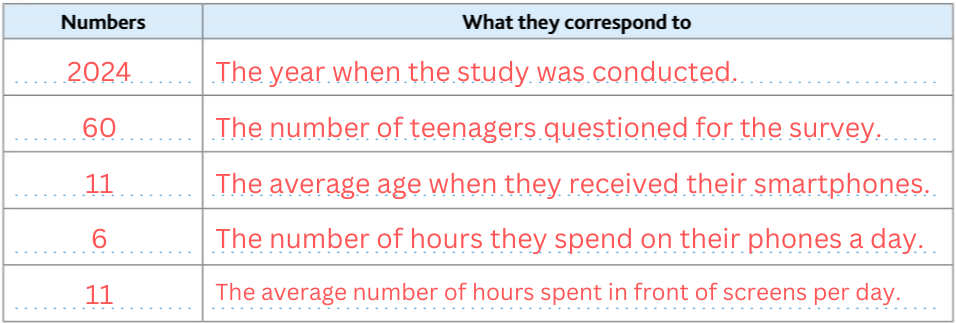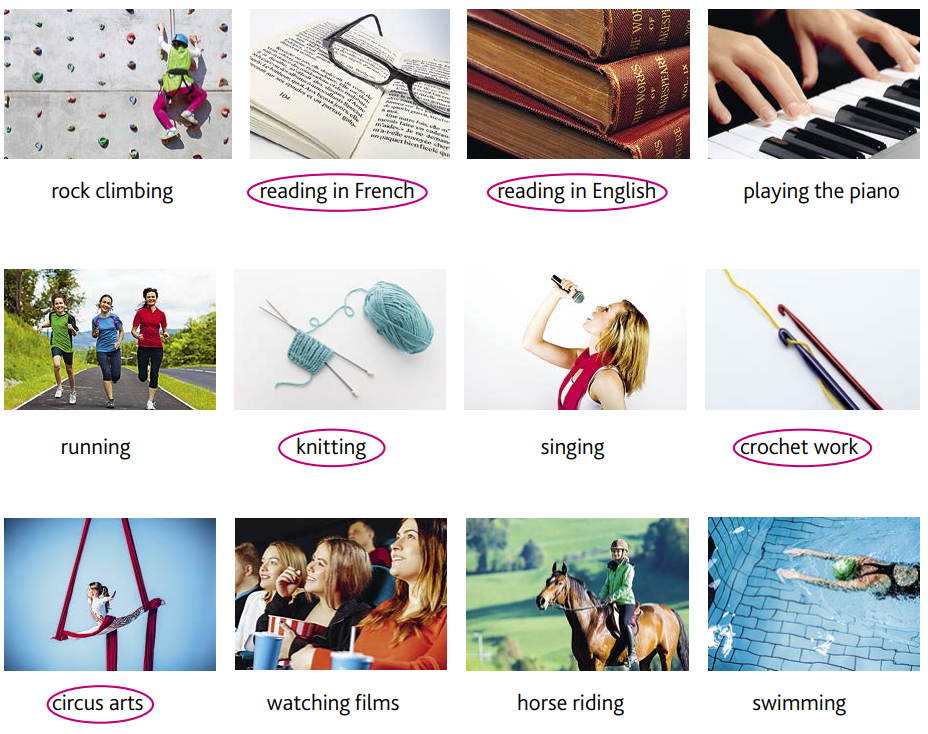Mes objectifs :
- Parler de mes habitudes.
Resources :
PDF: What’s cool in 2024.
PDF: Frequency Table.
PDF: Strange Hobbies.
Contents
Active Teens
Copy and translate these verbs to prepare for the next section
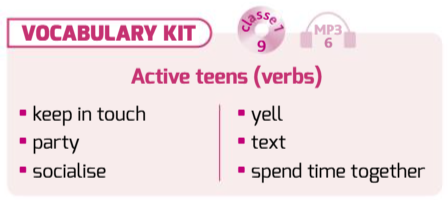
Look at the photo and guess who they are and what they are doing.

There is a group of teenagers, it looks like they are partying. They are yelling and they look very happy. Some of them have face paint. One is taking a selfie.
1 – According to the title and photo, what do you expect to learn in this article?

2 – Re-read the document Comprendre un document écrit. Now read the article. What are the two ideas expressed in the two paragraphs?

- A list of technological devices used by teenagers in 2024.
- A list of their favourite apps that they use.
3 – Copy words related to the two ideas; five words for idea one, two words for idea two.
- phone/smartphone, television sets, gaming consoles, desktop computers, screens
- Tiktok, Facebook
4 – There are five different numbers in this article, say what they correspond to.
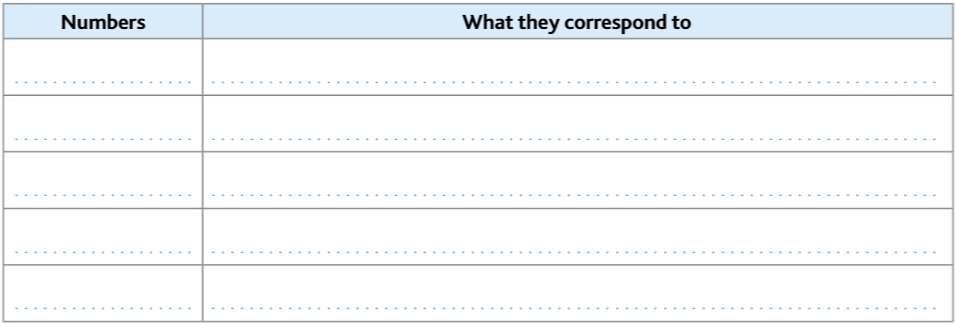
5 – Among the two apps mentioned in the article, which one is the teenagers’ favourite and which one is less liked? Justify your choice (avec une citation).
Favourite app:
Less liked app:
Favourite app: Tiktok (« most popular »)
Less liked app: Facebook (« it wasn’t their favourite app »)
6 – By using the words you wrote in question 3, and the numbers in question 4, sum up the typical teenage lifestyle in 2024.
Teenagers are very keen on technology. They spend 11 hours a day using it. For example, they use their smartphones, gaming consoles or computers. They particularly love their smartphones since they spend 6 hours a day in front of the screen, using all sorts of apps such as Tiktok or Facebook.
The present simple
Observe les phrases suivantes:
Sarah usually spends a lot of time in front of the TV.
They don’t like working.
Teenagers all have a smartphone.
Do they all have a computer?
Copie et complète les phrases suivantes:
Le présent simple sert à énoncer des cas particuliers / des généralités. Il est utilisé pour parler d’actions habituelles / d’actions en cours ou de caractéristiques. Il se forme avec la ……… dont la conjugaison ne change que pour la 3e personne du singulier, à laquelle il faut ajouter un ……… .
Avec une négation, on ajout l’auxiliaire ………, auquel on colle la particule de négation not.
Dans le cas d’un énoncé interrogatif, on commence par l’auxiliaire ……… conjugué à la bonne personne, on poursuit en ajoutant le sujet et enfin on place le complément / le sujet / la base verbale.
Le présent simple sert à énoncer des généralités. Il est utilisé pour parler d’actions habituelles ou de caractéristiques. Il se forme avec la base verbale dont la conjugaison ne change que pour la 3e personne du singulier, à laquelle il faut ajouter un s .
Avec une négation, on ajout l’auxiliaire do, auquel on colle la particule de négation not.
Dans le cas d’un énoncé interrogatif, on commence par l’auxiliaire do conjugué à la bonne personne, on poursuit en ajoutant le sujet et enfin on place la base verbale.
Frequency
Look and say as much as you can about this survey:
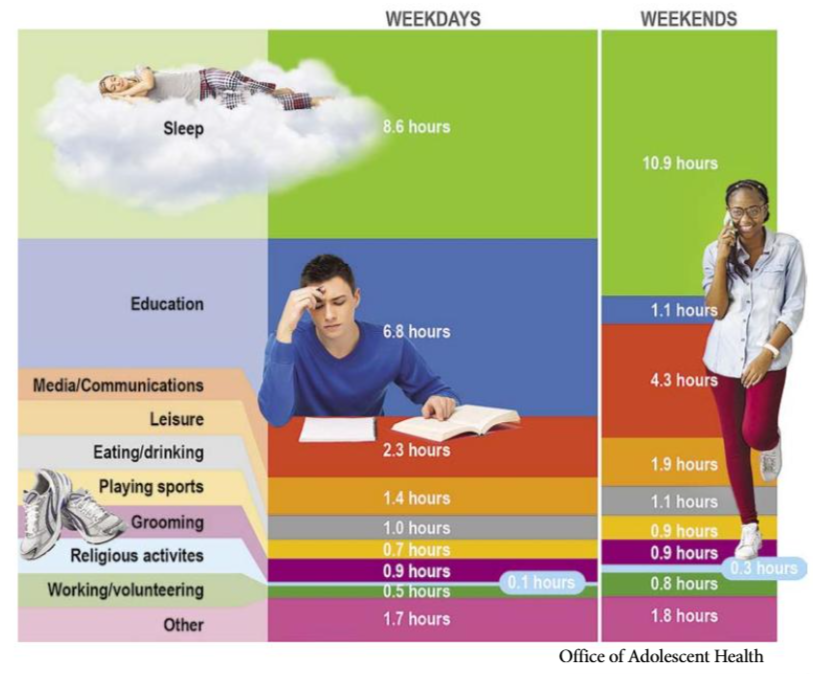
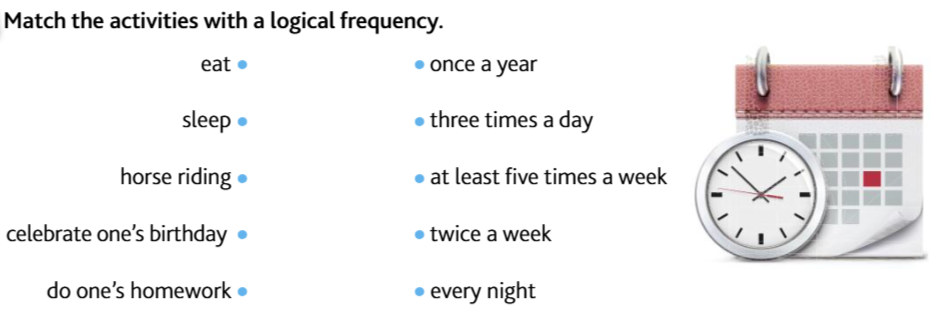
Fill in the top table with your personal timetable and the durations that you choose. (30 minutes, 6 hours etc.)
For « other », add an activity that isn’t mentioned in the table.
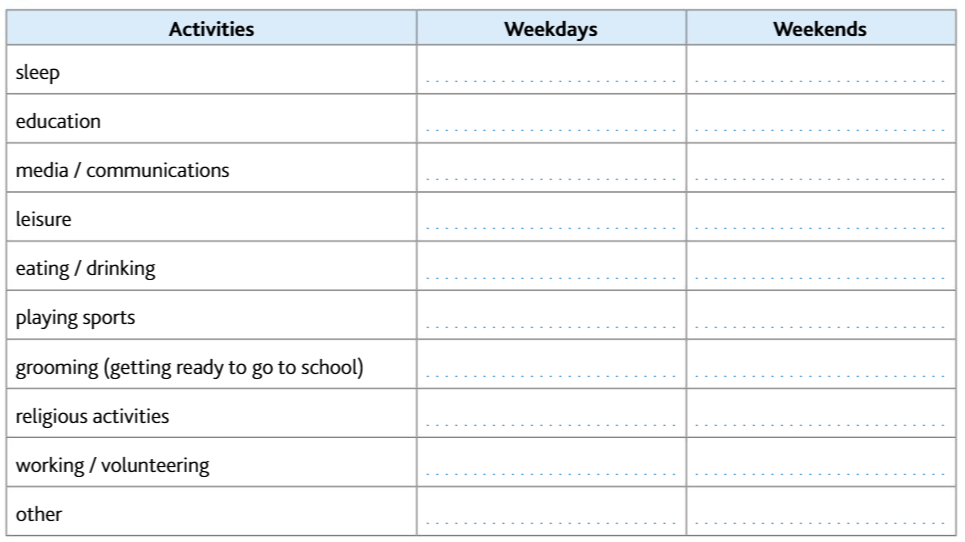
To find out the information in the table, we would ask the question: « How long do you spend on …. per day? »
« How long do you spend on playing sports per day on weekdays? »
« How long do you spend on education per day on weekends? »
Ask and answer questions to your partner in order to fill in the bottom table.
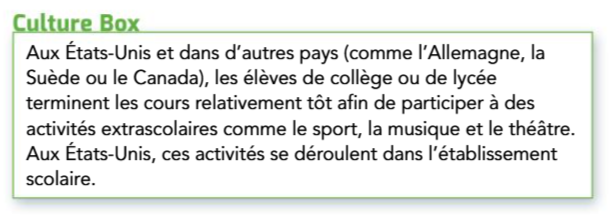
A teenager's story
Before we start, re-read the document Comprendre un document oral.
1 – Listen to the first sentence of this teenager. What is her name? What is she going to talk about?
This teenage girl’s name is Gabrielle and she is going to talk about her free time.
2 – Listen and write down all the words you hear.
like – free time – a lot – read – books – English – French – help – knit – crochet – get the chance – enjoy – circus arts
3 – Listen and point at all the activities you hear.
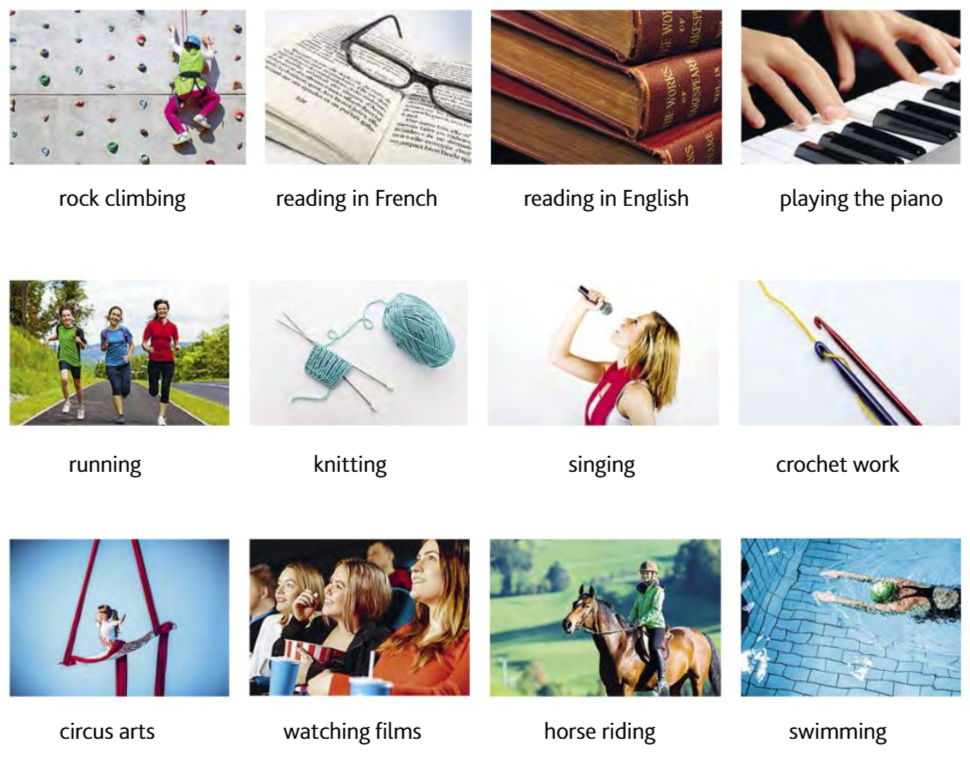
Write down and translate any new vocabulary.
4 – Listen again and find more information about her pleasure for reading.
She loves reading. She reads several books at a time. She reads books in both English and French. She wants to improve her French.
5 – Recap what you know about Gabrielle and her free time.
Les consonnes muettes
1 – Les douze photographies représentent chacune un mot contenant une consonne muette. Retrouve les douze mots. Si nécessaire, aide-toi d’un dictionnaire.
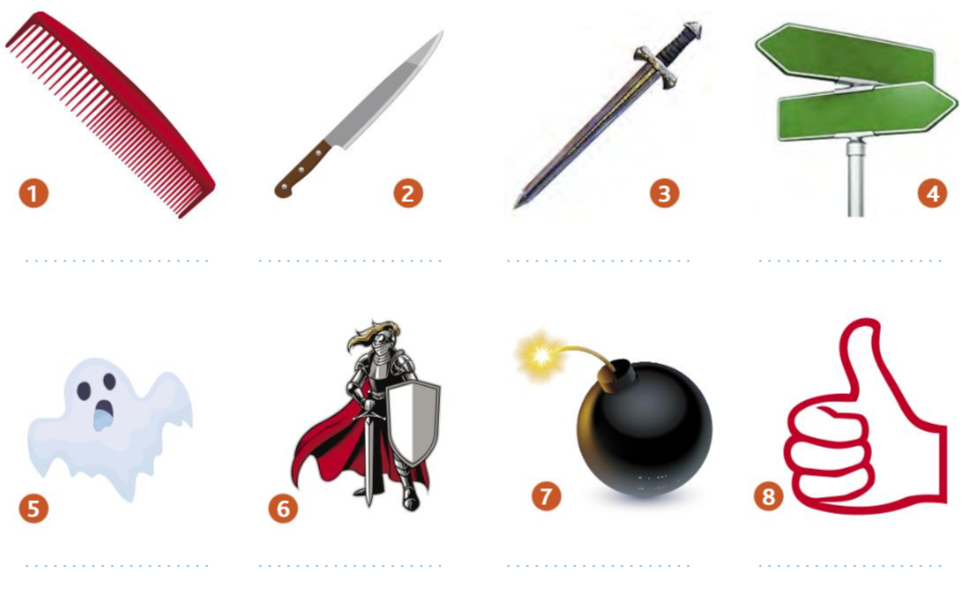

2 – Vérifie tes réponses en écoutant le professeur. Dans chacun des douze mots, entoure la consonne muette.
Comb – Knife – Sword – Sign
Ghost – Knight – Bomb – Thumb
Mechanic – Lamb – Tomb – Castle
3 – Read the following sentence out loud to practice your pronunciation.
The knight was buried with his sword in a stone tomb near the castle.
4 – Create your own sentence using as many of the twelve words as possible. Read it to the class.
Worksheet
Complete the worksheet strange hobbies.
Oral Evaluation
- Je regarde des séries télévisées tous les samedis.
- Nous aimons les arts du cirque.
- Claire adore regarder des films.
- Tu pratiques le piano quatre fois par semaine.
- Emma nage à la piscine chaque mercredi matin.
- Nous lisons en anglais tous les soirs.
- Elle adore chanter.
- Ils jouent du piano trois fois par mois.
- Tu fais du tricot deux fois par semaine.
- Ils aiment tricoter.
- Je fais du crochet tous les samedis après-midi.
- Il adore jouer du piano.
- Ils aiment jouer du piano.
- Paul étudie l’histoire deux fois par semaine.
- Il participe aux arts du cirque tous les jeudis.
- Claire et Sarah écrivent dans leurs journaux intimes tous les jours.
- Sarah et Claire détestent tricoter.
- Nous aimons regarder des films.
- Vous aimez regarder des films.
- Sarah est passionnée par le crochet.
- Paul court deux fois par semaine.
- Il chante chaque dimanche.
- J’aime beaucoup les arts du cirque.
- Tu détestes faire de l’équitation.
- Elle aime lire en français.
- Les enfants font de l’équitation tous les dimanches.
- Nous regardons des films chaque week-end.
- Emma fait du vélo tous les matins.
- Paul déteste nager.
- Ils regardent des films chaque vendredi soir.
- Paul aime courir.
- Marie fait de l’escalade chaque samedi.
- Ils aiment courir.
- Nous lisons des livres tous les soirs.
- Vous jouez du piano trois fois par semaine.
- Je déteste l’escalade.
- Paul lit en français deux fois par semaine.
- Nous avons cours d’anglais deux fois par semaine.
- Paul adore l’escalade.
- Je m’entraîne aux arts du cirque tous les samedis matin.
- Il est passionné par l’équitation.
- Claire et Sarah chantent chaque vendredi soir.
- Nous détestons lire en français.
- Tu aimes courir.
- Ils détestent le crochet.
- Emma aime beaucoup nager.
- Elle est fascinée par l’équitation.
- Elle joue au football chaque week-end.
- Emma déteste lire en anglais.
- Ils vont nager trois fois par mois.
